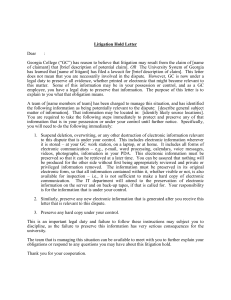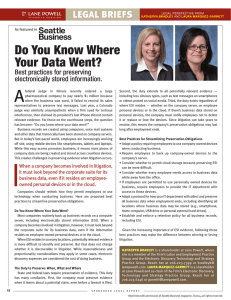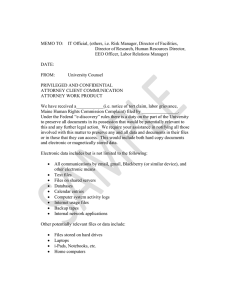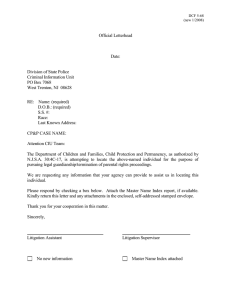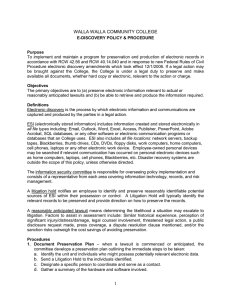- NDLScholarship
advertisement
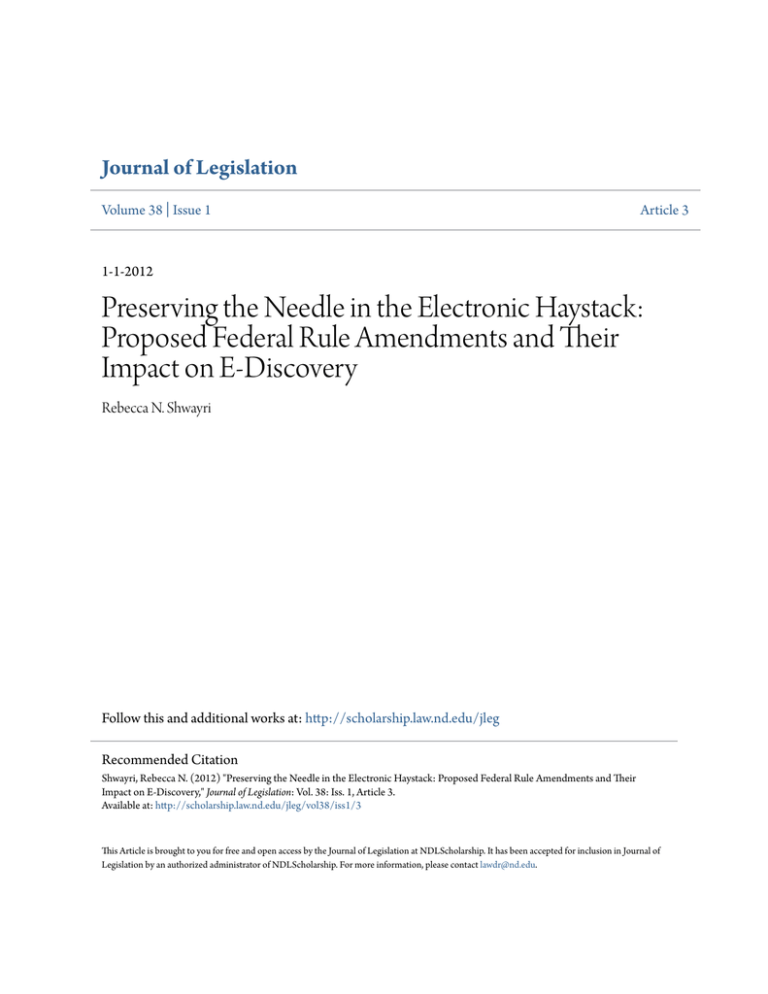
Journal of Legislation Volume 38 | Issue 1 Article 3 1-1-2012 Preserving the Needle in the Electronic Haystack: Proposed Federal Rule Amendments and Their Impact on E-Discovery Rebecca N. Shwayri Follow this and additional works at: http://scholarship.law.nd.edu/jleg Recommended Citation Shwayri, Rebecca N. (2012) "Preserving the Needle in the Electronic Haystack: Proposed Federal Rule Amendments and Their Impact on E-Discovery," Journal of Legislation: Vol. 38: Iss. 1, Article 3. Available at: http://scholarship.law.nd.edu/jleg/vol38/iss1/3 This Article is brought to you for free and open access by the Journal of Legislation at NDLScholarship. It has been accepted for inclusion in Journal of Legislation by an authorized administrator of NDLScholarship. For more information, please contact lawdr@nd.edu. PRESERVING THE NEEDLE IN THE ELECTRONIC HAYSTACK: PROPOSED FEDERAL RULE AMENDMENTS AND THEIR IMPACT ON E-DISCOVERY Rebecca N. Shwayri* The issue of preservation of electronically stored information ("ESI") has created thorny issues for litigants and the Bar. Today, it is well recognized that parties must utilize a litigation hold to preserve ESI when litigation is reasonably anticipated.' The use of a litigation hold as a way to preserve ESI that is relevant to litigation came into existence in 2003 as a result of Zubulake v. UBS Warburg, L.L.C.2 In that case, Judge Scheindlin explained that "[o]nce a party reasonably anticipates litigation, it must suspend its routine document retention/destruction policy and put in place a 'litigation hold.' 3 By 2010, Judge Scheindlin had found that the "common law duty to preserve evidence relevant to litigation is well recognized. "The case law makes crystal clear that the breach of the duty to preserve, and the resulting spoliation of evidence, may result in the imposition of sanctions by a court because the court has the obligation to ensure that the judicial process is not abused."5 The duty to preserve ESI relevant to the litigation is so well established that the failure to issue a written litigation hold constitutes "gross negligence."6 Despite the fact that the duty to preserve ESI is one that is clearly and affirmatively recognized by the courts, there has been great difficulty among litigants and the Bar in implementing preservation obligations. According to Kroll Ontrack, thirty-nine percent of e-discovery cases in 2010 were sanction cases, and forty-nine percent of those cases involved preservation and spoliation issues.7 In light of the fact that preservation of ESI is such a litigious issue, the Advisory Committee on the Civil Rules is considering whether rules changes should be adopted to address the issue of preservation of ESI. The Advisory committee has created three new frameworks that could be used to address * B.A., George Washington University, 2001; J.D., University of Florida College of Law, 2004; Associate at Carlton Fields, P.A. and member of firm's E-Discovery Task Force 1. Pension Comm. of the Univ. of Montreal Pension Plan v. Banc of Am. Sec., L.L.C., 685 F. Supp. 2d 456, 466 (S.D.N.Y. 2010) (citation omitted). 2. 220 F.R.D. 212 (S.D.N.Y. 2003). 3. Id at 218. 4. Pension Comm., 685 F. Supp. 2d at 466. 5. Id 6. Id at 465. 7. Year in Review: Kroll Ontrack 2010 Discovery Trend Data Reveals Organizations Struggle with Preservation, Production and General Discovery Protocols, KROLLONTRACK.COM, http://www.krollontrack.com/company/news-releases/?getPressRelease=61500 (last visited Nov. 7, 2011). 8. Ronald J. Hedges, Preservations and Sanctions Issues, in ELECTRONIC INFORMATION IN LITIGATION: EVERYTHING You NEED TO KNow 1 (2011), availableat ALI-ABA Topical Courses. 118 Preserving the Needle in the Electronic Haystack 2012] 119 preservation obligations under the Federal Rules of Civil Procedure. The first framework attempts to give litigants a higher degree of specificity by providing a detailed explanation of the duty to preserve and possible trigger events.9 The second framework is very similar to the first proposed framework, but creates a more general preservation rule while the third framework proposes a back-end sanctions rule. 10 This article will analyze the three proposed rule amendments to the Federal Rules of Civil Procedure. Part I of this article will explain the current framework for preservation of ESI under the common law and Sedona Conference Principles. Part II will opine as to the efficacy of each of the three proposed frameworks created by the Advisory Committee on the Civil Rules. Finally, Part III of this article will conclude the analysis by addressing whether amendments to the Federal Rules of Civil Procedure are even the proper avenue to address problems that have arisen with respect to preservation obligations. I. OVERVIEW OF THE CURRENT LITIGATION HOLD FRAMEWORK: A FACT SPECIFIC QUERY A. Concept ofLitigationHolds under a Common Law Approach: Determining When There is a Reasonable Anticipation ofLitigation Zubulake is the seminal case describing the duty to preserve ESI." In that case, the plaintiff, Laura Zubulake, was an equities trader with UBS and sued UBS for gender discrimination, failure to promote, and retaliation.12 The plaintiff maintained that the evidence she needed to prove her case existed in e-mail correspondence sent among UBS employees.1 3 On August 16, 2001, the plaintiff filed her EEOC charge.14 On February 14, 2002, the plaintiff filed her case in federal court. 15 The plaintiff sought sanctions from UBS for its failure to preserve missing backup tapes and deleted e-mails.16 In evaluating the plaintiff's motion, the court explained that a party can only be sanctioned if it had a duty to preserve evidence.' 7 If there was no duty to preserve, the party cannot be found at fault.' 8 "The obligation to preserve evidence arises when the party has notice that the evidence is relevant to litigation or when a party should have known that the evidence may be relevant to future litigation."' 9 The 9. 10. I1. 12. 13. 14. 15. 16. 17. 18. 19. Id. at 2. Id. 220 F.R.D. 212. Id. at 215. Id. Id. Id. Id. Id. at 216. Id. Id. (quoting Fujitsu Ltd. v. Federal Express Corp., 247 F.3d 423, 436 (2d Cir. 2001)). JournalofLegislation 120 [Vol. 38:1 issues facing the court were to determine when the duty to preserve attached and what evidence should be preserved. 20 The court found that the latest trigger date was August 16, 2001, the date that the plaintiff had filed her EEOC charge.21 However, the court ultimately found that the duty to preserve arose as early as April 2001, when other employees recognized that the plaintiff was preparing to file suit and sent e-mails with attorney-client privilege designations expressing that fact. 22 After determining the trigger point for the duty to preserve, the court analyzed what a party must preserve once the duty arises.23 The duty to preserve extended to documents made by individuals "likely to have discoverable information that the disclosing party may use to support its claims and defenses" in the litigation.24 The duty extended to documents prepared for those individuals and documents containing information relevant to the claims and defenses of any party.25 The court held that UBS had a duty to preserve the back-up tapes and ordered UBS to pay the costs of additional depositions. 26 While the Zubulake court created the concept of litigation holds with respect to ESI, the same court in Pension Committee emphasized what was implicitly not obvious only a few years ago. In Pension Committee, a group of investors brought suit to recover losses of $550 million arising out of the liquidation of two hedge funds.27 The defendants moved for sanctions claiming that each plaintiff failed to produce and preserve documents and submitted false declarations.28 The court began its analysis by giving an overview of the law on litigation holds. 29 Specifically, the court opined that the "intentional destruction of relevant records, either paper or electronic, after the duty to preserve has attached is willful." 30 After the Zubulake opinion was issued, the failure to issue a written litigation hold is "grossly negligent" because the failure is likely to result in the destruction of relevant ESI.31 The court further explained that the failure to collect recordseither paper or electronic-from key players constitutes gross negligence or willfulness.32 The failure to preserve all appropriate measures to preserve ESI constitutes negligence. 33 Ultimately, the court elaborated that the "common law duty to preserve evidence relevant to litigation is well recognized." 34 20. 21. 22. 23. 24. 25. 26. 27. 28. 29. 30. 31. 32. 33. 34. Id. Id. Id. at 217. Id. at 217-218. Id. (quoting FED. R. Civ. P. 26(a)(1)(A)). Id.at 218. Id. at 222. 685 F. Supp. 2d at 462. Id at 463. Id. Id at 464. Id at 465. Id. Id. Id. at 466. 2012] Preservingthe Needle in the Electronic Haystack I121 While Zubulake and Pension Committee emphasize the clarity of the litigation hold rule, the court in Rimkus Consulting Group v. Cammarata stated that the application of the rule is fact-specific and based on reasonableness.35 In that case, the court found that the rule enunciated in Zubulake was not controversial. 36 Despite the non-controversial nature of the rule, the court found that: It can be difficult to draw bright-line distinctions between acceptable and unacceptable conduct in preserving information and in conducting discovery, either prospectively or with the benefit (and distortion) of hindsight. Whether preservation or discovery conduct is acceptable in a case depends on what is reasonable,and that in turn depends on whether what was done - or not done was proportionalto that case and consistent with clearly established applicable standards. 3 The Court further opined that the reasonableness of discovery can depend upon the facts of the case. 38 "[T]he reasonableness of discovery burdens in a $550 million case arising out of the liquidation of hedge funds, as in Pension Committee, will be different than the reasonableness of discovery burdens in a suit to enforce noncompetition agreements and related issues, as in the present case."39 B. Sedona Conference Principlesas to a Party'sPreservation Obligation Following the lead of the Zubulake, Pension Committee, and Rimkus decisions, the Sedona Conference has articulated principles to guide organizations, individuals, and lawyers with respect to their preservation obligations.40 The Sedona Conference recognizes that defining the point in time in which the duty to preserve arises is sometimes clear-cut.41 For example, if an organization receives a summons, complaint, or subpoena or formal notice that it is the target of a governmental investigation, then the organization is on notice that the duty to preserve has arisen.42 In other circumstances, the duty to preserve is a bit more ambiguous. 4 3 For example, if an insurance company has received notice of a claim from the insured, the notice may not trigger the reasonable anticipation of litigation because the insurance company is in the business of paying claims without litigation. 44 If an organization receives a letter demanding that it preserve ESI, that 35. Rimkus Consulting Grp., Inc. v. Cammarata, 688 F. Supp. 2d 598, 613 (S.D. Tex. 2010). 36. Id. at 612-13. 37. Id. at 613. 38. Id. at 613 n.9. 39. Id. 40. See The Sedona Conference, Commentary on Legal Holds: The Trigger & The Process, 11 SEDONA CONF. J. 265, 271-77 (2010). 41. Id. at 271. 42. Id. 43. See id. 44. Id. Journal of Legislation 122 [Vol. 38:1 preservation notice may or may not trigger the organization's preservation obligations. 45 The organization must identify the credibility of the threat of litigation and determine whether it would be reasonable to anticipate litigation based on the threat.46 Ultimately, the duty to preserve is triggered "only when an organization concludes . . . based on credible facts and circumstances, that litigation or a government inquiry is probable." 47 Whether litigation can be reasonably anticipated is a fact-specific inquiry.48 Driving the analysis is a "good faith" and "reasonable evaluation" of facts and circumstances as known at the time. 49 Certain types of notice do not give rise to a duty to preserve. For example, if an organization receives a vague threat of litigation, such a vague threat will not trigger the duty to preserve ESI.5 0 A threat may also be deemed to lack credibility based on the nature of the threat, the person making the threat, or the legal bases upon which the threat is based. Ultimately, a "reasoned analysis of the available facts and circumstances" is required in order to determine whether or not the litigation or government investigation is reasonably anticipated.52 Factors that are pertinent to the inquiry include the specificity of the claim, the party making the claim, the business relationship between the parties, whether the threat is explicit or implicit, whether the party making the threat is known to be litigious, the strength and scope of the anticipated claim, whether the organization is aware of similar claims, and reputable press coverage of the issue pertaining to similarly made complaints in the industry. 5 II. THE EFFICACY OF THE PROPOSED AMENDMENTS TO THE FEDERAL RULES OF CIVIL PROCEDURE The Advisory Committee on Civil Rules is considering three frameworks for addressing issues faced by parties and litigants in preserving ESI. 5 4 Each of these frameworks has advantages and drawbacks. A. The FirstProposedFramework:Attempting to Impose Specificity The first proposed framework considered by the Advisory Committee attempts to provide a high degree of specificity by giving a list of scenarios that would trigger the duty to preserve.55 Proposed Rule 26.1 reads as follows: 45. 46. demand 47. 48. 49. 50. 51. 52. 53. 54. 55. Id. See Cache La Poudre Fees L.L.C. v. Land O'Lakes, Inc., 244 F.R.D. 614, 623 (D. Colo. 2007) (a letter referencing "exposure" did not trigger the obligations to preserve ESI). Sedona Conference, supranote 40, at 272 (emphasis omitted). Id. Id. Id. Id. Id. Id.at 276. Hedges, supra note 8, at 2. Id. 2012] Preservingthe Needle in the Electronic Haystack I123 Rule 26.1 .Duty to Preserve Discoverable Information (a) General Duty to Preserve. [In addition to any duty to preserve information provided by other law,] every person who reasonably expects [is reasonably certain] to be a party to an action cognizable in a United States court must preserve discoverable [electronically stored] information as follows. (b) Trigger for Duty to Preserve. The duty to preserve discoverable information under Rule 26.1(a) arises only if a person becomes aware of one of the following facts or circumstances that would lead a reasonable person to expect to be a party to an action [cognizable in a United States court]: (1) Service of a pleading or other document asserting a claim; or (2) Receipt of a notice of claim or other communication-whether formal or informal-indicating an intention to assert a claim; or (3) Service of a subpoena or similar demand for information; or (4) Retention of counsel, retention of an expert witness or consultant, testing of materials, discussion of possible compromise of a claim or taking any other action in anticipation of litigation; or (5) Receipt by the person of a notice or demand to preserve discoverable information; or (6) The occurrence of an event that results in a duty to preserve information under a statute, regulation, contract, or knowledge of an event that calls for preservation under the person's own retention program. [(7) Any other [extraordinary] circumstance that would make a reasonable 56 person aware of the need to preserve information.] While the case law describes preservation obligations in terms of the vague and nebulous "reasonable anticipation of litigation" standard, proposed Rule 26.1 is an attempt to qualify certain facts and circumstances which would trigger the imposition of a litigation hold. Unfortunately, some of the circumstances that would trigger the duty to preserve are vague and underlie the difficulty in proposing a specific rule encompassing all possible triggers. For example, Rule 26.1(b)(2) provides that a receipt of a notice of claim or other communication may trigger the duty to preserve. The notice could be formal or informal. This rule raises the question of the type of informal notice could trigger the duty to preserve information. What would the informal notice look like and who would send the informal notice? Would informal notice be provided by the party or by its attorney? What if the informal notice did not contain a very specific threat but only a vague and general claim that litigation could be brought at sometime in the future? The legal departments of large companies routinely receive letters-some meritorious and some not so meritorious-describing litigation that might be filed and the need to preserve ESI. Rule 26.1(b)(2) may actually broaden a company's obligation to preserve and retain ESI. Other provisions of proposed Rule 26.1(b) are equally problematic. Rule 26.1(b)(5) provides that receipt by the person of a notice or demand to preserve 56. Id. at 4-7 (footnotes omitted). 124 JournalofLegislation [Vol. 38:1 discoverable information may trigger a litigation hold. This subsection raises more questions than it answers. For instance, this subsection does not define the contours of the notice, the type of specificity required, and the credibility of the threat. Because Rule 26.1 is designed to be an all-encompassing catalog of triggers, the Advisory Committee felt that providing a catch-all section was necessary. This catch-all is provided in Rule 26.1(b)(7) and provides that a litigation hold should be imposed for "[a]ny other [extraordinary] circumstances that would make a reasonable person aware of the need to preserve information."5 8 If the intent of the Advisory Committee is to create a rule that provides predictability and certainty, the catch-all section destroys any chance of predictability and certainty; the catchall ultimately swallows up the rule. The inclusion of the catch-all demonstrates the challenge of providing certainty without creating a rule that is inflexible in light of changing technologies. While the Advisory Committee hopes to provide a level of guidance and specificity, an all-encompassing catch-all creates an opportunity for litigants to claim that their specific case fits within the exception to the rule. A key benefit to having a detailed, specific rule is to apprise parties and litigants of the times in which the duty to preserve evidence is triggered. While the duty to preserve may be triggered before litigation is filed, the Federal Rules of Civil Procedure are designed to address procedural aspects of litigating in the federal courts of the United States after litigation has been filed.5 9 It is questionable whether creating a rule describing pre-litigation obligations is one that is within the purview of the Advisory Committee or could even be addressed by a Federal Rule of Civil Procedure. The first framework proposed by the Advisory Committee ultimately creates By attempting to invent every possible more questions than it answers. circumstance in which a litigation hold is triggered, the Committee paints very broad brush strokes. It is likely that the new rule would be the subject of additional litigation in the e-discovery field and could create a new (and unnecessary) cottage industry of litigation. B. Second ProposedFramework: A GeneralGuideline The second framework is a more general rule regarding preservation, but some guidance is provided. The key question is whether such a general framework would even benefit the parties in making preservation decisions. The proposed rule reads as follows: Rule 26.1. Duty to Preserve Discoverable Information (a) General Duty to Preserve. [In addition to any duty to preserve information provided by other law,] every person who reasonably expects [is 57. Id.at7n.13. 58. Id. at 7. 59. See FED. R. CIv. P. 1 ("These rules govern the procedure in all civil actions and proceedings in the United States district courts .... ). 2012] Preservingthe Needle in the ElectronicHaystack 125 reasonably certain] to be a party to an action cognizable in a United States court must preserve discoverable [electronically stored] information in as follows. (b) Trigger for Duty to Preserve. [Alternative 1] The duty to preserve discoverable information under Rule 26.1(a) arises when a person becomes aware of facts or circumstances that would lead a reasonable person to expect to be a party to an action [cognizable in a United States court]. (b) Trigger for Duty to Preserve. [Alternative 2] The duty to preserve discoverable information arises when a person becomes aware of facts or circumstances that would lead a reasonable person to expect to be a party to an action [cognizable in a United States court] such as: (1) Service of a pleading or other document asserting a claim; or (2) Receipt of a notice of claim or other communication-whether formal or informal-indicating an intention to assert a claim; or (3) Service of a subpoena or similar demand for information; or (4) Retention of counsel, retention of an expert witness or consultant, testing of materials, discussion of possible compromise of a claim or taking any other action in anticipation of litigation; or (5) Receipt of a notice or demand to preserve discoverable information; or (6) The occurrence of an event that results in a duty to preserve information under a statute, regulation, contract, or the person's own retention 60 program. The first alternative to Rule 26.1(b) is nothing more than an attempt to codify the common law rule providing that the litigation duty is triggered upon reasonable anticipation of litigation. Simply rephrasing the common law rule in the Federal Rules of Civil Procedure does not provide any level of predictability to litigants. On the other hand, evaluating conduct based on reasonableness is arguably a more workable framework than attempting to invent every possible scenario in which a litigation hold could be triggered. In light of rapidly evolving technologies, a more flexible framework is superior to one that attempts to delineate a strict list of factors that could be outdated within a few years. The second alternative to Rule 26.1(b) poses the same problems as the first framework. Listing a series of triggering actions does not provide certainty or predictability when the contours of the triggering action are vague. C. Third ProposedFramework:Imposing Sanctions The third framework proposed by the Advisory Committee is to create a backward looking rule by imposing sanctions for failing to preserve discoverable information. According to proposed Rule 37, "[ilf a party fails to preserve discoverable information that reasonably should be preserved in the anticipation or conduct of litigation, the court may ... (A) permit additional discovery; (B) order 60. Hedges, supra note 8, at 19-20. 126 JournalofLegislation [Vol. 38: 1 the party to undertake curative measures;" or require the payment of attorneys' fees. 6 1 The rule imposes a willfulness or bad faith standard for the imposition of sanctions.62 In determining whether the failure to impose discoverable information was willful or in bad faith, according to proposed Rule 37(g)(3) the court may consider the following factors: (A)the extent to which the party was on notice that litigation was likely and that the information would be discoverable; (B) the reasonableness of the party's efforts to preserve the information, including the use of a litigation hold and the scope of the preservation efforts; (C)whether the party received a request that information be preserved, the clarity and reasonableness of the request, and-if a request was madewhether the person who made the request or the party offered to engage in good-faith consultation regarding the scope of preservation; (D) the party's resources and sophistication in matters of litigation; (E) the proportionality of the preservation efforts to any anticipated or ongoing litigation; and (F) whether the party sought timely guidance from the court regarding any unresolved disputes concerning the preservation of discoverable information.63 While the rule intends to impose a willfulness standard, certain subsections of this rule are vague and make a willfulness determination more difficult. For example, would merely ignoring the possibility of litigation be enough to constitute willfulness under the proposed rule? What level of notice would a party need to have before willfulness would be found? Subsection 3(A) leaves open the possibility of behavior occurring over a broad spectrum. The unanswered question is the level of behavior that would trigger the sanction. Subsection 3(C) requires an evaluation of whether a party received a request that information be preserved, an evaluation of the clarity of the request, and an evaluation of whether there was a good-faith consultation regarding the scope of the preservation. Suppose an organization receives a vague request (a frequent occurrence among large organizations that are often serial litigants), would the organization's act of engaging in discussions related to the scope of a litigation hold be used against the organization in a future sanctions motion? As it stands, under the Sedona Conference principles, vague demands are not grounds for implementing preservation obligations and should not be used against a party in a sanctions motion. 64 Subsection 3(D) requires an analysis of the resources of the party and the party's sophistication. The idea behind subsection 3(D) is that sophisticated, 61. 62. 63. 64. Id at 23. Id at 24. Id at 24-25 (footnotes omitted). Sedona Conference, supra note 40, at 272. 2012] Preservingthe Needle in the ElectronicHaystack 127 corporate entities have an easier time dealing with e-discovery issues due to their vast resources and that individual litigants may not have such resources available. Under this subsection, an individual litigant would be held to a lower standard. Unfortunately, subsection 3(D) creates a double standard whereby well-funded corporate litigants are more likely to be subject to sanctions compared to individual litigants. The third framework represents an attempt to impose predictability on the backend of the process rather than the front end. The vagueness of certain aspects of subsection 3 is problematic and would likely create more litigation rather than less. Even more important, it is questionable whether the Advisory Committee could even impose a sanctions standard without running afoul of the Rules Enabling Act. 65 Pursuant to the Rules Enabling Act, the judiciary has the power to promulgate rules of procedure, but not substantive rules. 67 A rule of civil "procedure" altering the common law sanctions standards that have developed disparately across the United States could be construed as substantive rather than procedural. Such a rule may not be promulgated pursuant to the Rules Enabling Act. III. EVALUATING THE NECESSITY OF THE AMENDMENTS TO THE FEDERAL RULES OF CIVIL PROCEDURE While the new frameworks being considered by the Advisory Committee represent an admirable attempt to provide more guidance and certainty to an inherently flexible area of the law, the reasonableness standard as articulated by the federal courts is a better framework for litigants and the Bar in the long run. The rule requiring litigation holds to be imposed when there is a reasonable anticipation of litigation is clear, although the application of the rule may be opaque to the uneducated. When it comes to preservation obligations, the real source of the problem is not a lack of clarity in the rule articulated by courts. The crux of the problem lies in a lack of education by the Bar and the failure of organizations to manage their ESI. New rules will not make a difference to the already uneducated Education-rather than additional who do not comprehend the basics. rulemaking-would contribute to a large reduction in sanctions motions for failing to preserve ESI. 65. 28 U.S.C. §2072 (2006). 66. Id. at § 2072(a). 67. Id. at §2072(b).
